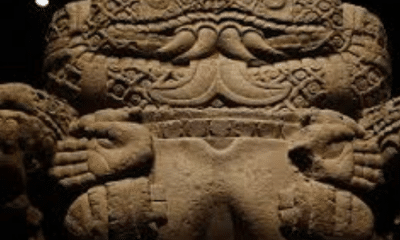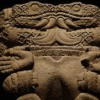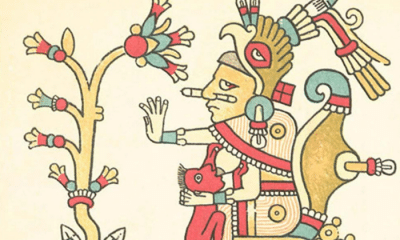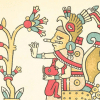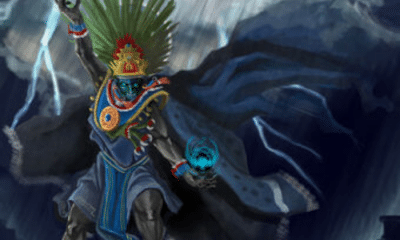
Aztec
Chalchiuhtlicue: The Aztec Goddess of Water
Chalchiuhtlicue: The Aztec Goddess of Water
In the Aztec religion, Chalchiuhtlicue was the goddess of water, but she was also the only goddess to have been the sun. Keep reading to find out how the loving goddess of water failed the world as the sun!
Chalchiuhtlicue was an important goddess in the Aztec religion.
As a water goddess, she was vital to all aspects of life. Without her, crops and humans alike would die of thirst.
This made her an important fertility goddess. This was reflected in her kind personality and compassion toward mothers and infants.
Despite her loving nature, however, Chalchiuhtlicue could be dangerous.
Although she was not malicious, Chalchiuhtlicue had the power to destroy the entire world. She did just that during her brief reign as the fourth sun of the world.
Chalchiuhtlicue was not malicious or hateful. Instead, she was deadly because of the very emotions that made her so kind.
Chalchiuhtlicue and the Sun
In Aztec mythology, Chalchiuhtlicue was a prominent goddess of water.
She was sometimes said to be the wife of Tlaloc, the rain god. Unlike him, however, she was associated with groundwater instead of falling rain.
Together, the two ruled over the land of Tlalocan. Described as a paradise, it was a rich and fertile land where those who died by drowning or of water-born diseases spent the afterlife.
She is most well-known, however, for her role in the Aztec creation myth.
According to the myth of the Five Suns, the world was in its fifth era of creation.
The gods had made the world four previous times before this age. Each version of the world had its own people and its own sun.
Many gods took on the role of the sun, but each failed at it. Chalchiuhtlicue was one of the deities who took the place of the sun only to destroy the world.
Tlaloc had been the third sun god, following the destruction of Tezcatlipoca and the winds of Quetzalcoatl. He, however, had sent a rain of fire to destroy people that he felt were wicked.
Chalchiuhtlicue took his place as the fourth sun, the only goddess to hold the position. Initially, she performed her duties well.
Chalchiuhtlicue was a naturally nurturing and good-natured goddess. She showed great love for her people and made the land fertile and rich for their benefit.
Tezcatlipoca, however, had been jealous of every god who had been the sun since his time. Unable to stir Chalchiuhtlicue to the same anger that had gripped the other sun gods, he used her soft heart against her.
Tezcatipoca mocked Chalchiuhtlicue’s kindness. He claimed that she was only faking the love she felt toward her people and that she was secretly kind only so they would give her adoration.
Chalchiuhtlicue was a sensitive goddess and this accusation hurt her greatly. She began to cry and, being a water goddess, could not stop.
The sun goddess cried for fifty-two years. According to some legends, her tears flowed so hard that they turned to blood.
The world was drowned in her deluge of tears. The people of the fourth age turned into fish to survive.
One legend claimed that the flood was so severe that the heavens collapsed. Tezcatlipoca and Quetzalcoatl had to become giant trees to hold them up until Chalchiuhtlicue’s flood receded.
My Modern Interpretation
The story of Chalchiuhtlicue’s flood shows her dual role as a goddess of both creation and destruction.
Like many cultures, the Aztecs saw their water deities as responsible for fertility. Rain and groundwater supplies were necessary to make crops grow.
As a female water deity, Chalchiuhtlicue was even more closely linked to human fertility. In addition to lakes and springs, she was also the goddess of amniotic fluid, the water that flowed during childbirth.
Chalchiuhtlicue was thus a protector of expectant mothers, pregnancy, and newborn children. Legends in which she was the mother of the moon god furthered her link to female fertility and birth.
Midwives prayed to Chalchiuhtlicue during their work. After a child was born, it was washed in water and consecrated in Chalchiuhtlicue’s name.
Because of this, Chalchiuhtlicue was depicted as a loving and caring goddess. Unlike the many Aztec gods who relished violence and warfare, she was tender-hearted and generous.
This generosity, however, masked a real danger.
Water gives life, but it is also unpredictable. The Aztecs were not the only culture to have a devastating flood myth.
The arid climate of much of Mexico makes water especially precious, but it also increases the risks of flash floods. A heavy rainfall or meltwater from the mountains clan lead to valleys and flatlands being flooded in a very short period of time.
As the goddess of the fourth sun, Chalchiuhtlicue showed that water can be as destructive as it is life-giving. While her world began as prosperous and happy, her unstoppable tears soon destroyed it.
This also made Chalchiuhtlicue a fitting goddess for a realm of the afterlife.
Deaths associated with water were so common that they had their own afterlife. Tlalocan welcomed not only those who had drowned, but also those killed by lightning strikes.
Certain diseases were linked to water, as well. In some legends, Chalchiuhtlicue also welcomed children who died in their first year of life into her afterlife.
Chalchiuhtlicue never stopped loving the people of the fourth age, though. They turned into fish and lived on in the lakes and rivers that were her domain.
Some scholars believe that she also lives on in contemporary Mexican folklore.
One common legend from Mexico is that of La Llorona, the Weeping Woman. Said to haunt the Rio Grande, she is supposedly the spirit of a mother who drowned her children.
In contemporary versions of native religion, the watery plane of the afterlife is also said to be ruled by a deity known as La Llorona.
The association with water, drowning, and tears draw obvious parallels between these figures and Chalchiuhtlicue. The La Llorona ghost story has another connection in that the spirit, like Chalchiuhtlicue, is said to be maternal.
In Summary
Chalchiuhtlicue was a goddess of water in the Aztec pantheon. She was associated with groundwater more than rain.
Despite this, however, she once caused a rain that lasted so long that it destroyed an entire age of the earth.
Int he Aztec creation myth, Chalchiuhtlicue was the fourth of the five suns that had ruled over the world. She was kind and loving.
Tezcatlipoca, however, taunted her and claimed that her good nature was a ruse. Hurt by this allegation, she cried for over fifty years.
Her tears flooded the Earth, destroying it. The people of her age turned into fish who would always live in her waters.
The story shows Chalchiuhtlicue’s role as both a loving and dangerous goddess.
As a water deity, she was associated with fertility and creation. She was especially important as a goddess of childbirth and was thought to lavish care and good will on laboring mothers and newborns.
She was also, however, capable of sending devastating floods. Her destruction was so common that an entire afterlife was devoted to people who died by drowning, in storms, or due to water-born illnesses.


